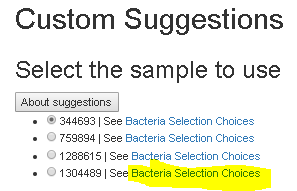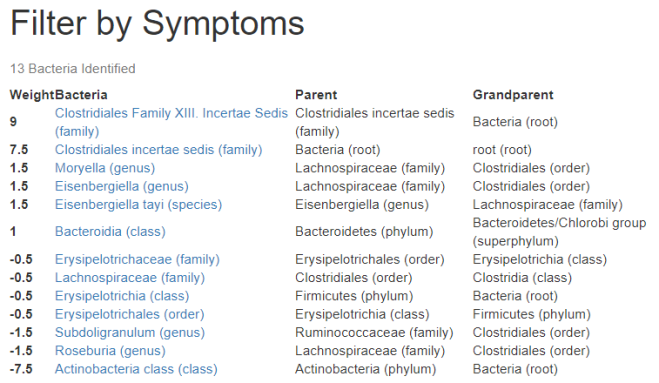Some readers have requested that I show the list of bacteria that were selected to make suggestions from. I have done some refactoring and they are now available from three different ways of selecting bacteria that are available on the site now. Reports go down to the strain in some cases.
Choices for Determining What you wish to change
Once you have logged on, if you select Advanced Suggestions

http://microbiomeprescription.azurewebsites.net/email/samples
You will go to the custom suggestions page. On this page, you will see your samples and links for Bacteria Selection choices.

http://microbiomeprescription.azurewebsites.net/data/CustomSuggestions?sampleid=….
There are multiple paths available for determining what could be wrong, and thus what you may wish to modify. Click on the above high lighted link will show you the actual bacteria picked from each of these methods. A short summary of each is below:

The Parents and Grandparents are included because most people do not know which family some genus or species is in.
I did some counts on different samples, which confirms the counts from each method.

Note: The symptom and outlier filter is dynamic. As more data is added, their ability to detect improves. For symptoms, there must be 16 people people reporting the same symptom before we will do detection of association.
In Summary
You can try all three methods, and experiment. You really want to get the smallest list of bacteria (because in figuring out suggestions, the more bacteria you include, the more complex it gets!).
For myself, I did suggestions from each and found a few items appeared in common with all of them. Those items are definitely on my list (“Almonds in the morning, Almonds in the Evening, Almonds at supper time”) sung to the tune below..
Choices for Determining What you wish to change
Once you have logged on, if you select Advanced Suggestions

http://microbiomeprescription.azurewebsites.net/email/samples
You will go to the custom suggestions page. On this page, you will see your samples and links for Bacteria Selection choices.

http://microbiomeprescription.azurewebsites.net/data/CustomSuggestions?sampleid=….
There are multiple paths available for determining what could be wrong, and thus what you may wish to modify. Click on the above high lighted link will show you the actual bacteria picked from each of these methods. A short summary of each is below:
- Bacteria that has an association with symptoms that you have and you are an exact match. This will be the smallest list — but it is the most certain of being right
- Bacteria whose population are outliers (that is far away from the expected patterns). This is the medium size list — it is uncertain if they are significant
- Bacteria above or below normal ranges. This is the simplest to understand and may be most leading. The typical 16S report has 500 to 1500 bacteria listed. Assuming the normal range is the middle 90% (5% high and 5% low), we would get 50 to 150 bacteria listed here by random chance.

The Parents and Grandparents are included because most people do not know which family some genus or species is in.
I did some counts on different samples, which confirms the counts from each method.

Note: The symptom and outlier filter is dynamic. As more data is added, their ability to detect improves. For symptoms, there must be 16 people people reporting the same symptom before we will do detection of association.
In Summary
You can try all three methods, and experiment. You really want to get the smallest list of bacteria (because in figuring out suggestions, the more bacteria you include, the more complex it gets!).
For myself, I did suggestions from each and found a few items appeared in common with all of them. Those items are definitely on my list (“Almonds in the morning, Almonds in the Evening, Almonds at supper time”) sung to the tune below..
